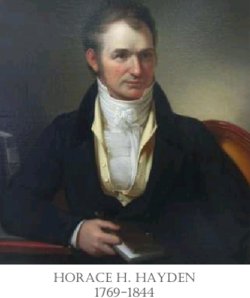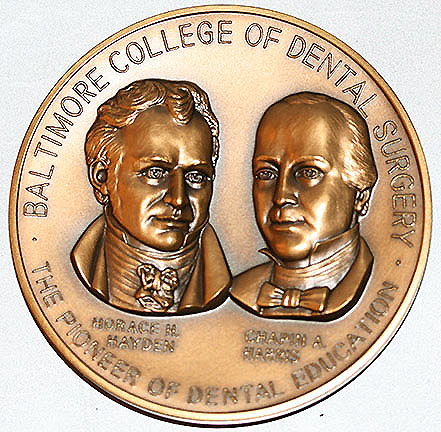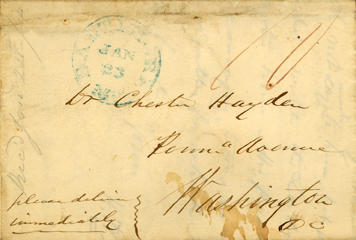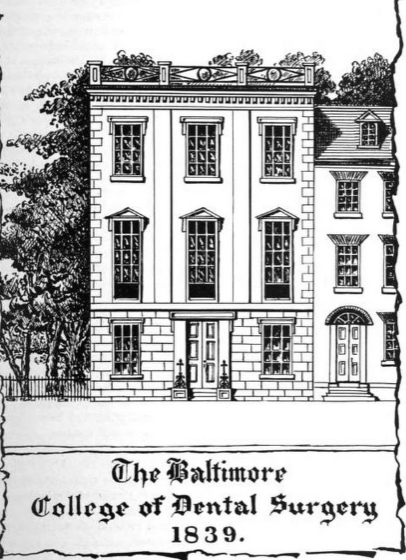A co-founder along with Dr. Chapin A, Harris of the first dental school in the world, the Baltimore College of Dental Surgery, which opened in 1840.
The following text about Dr. Hayden's life is taken from the history of the Baltimore College of Dental Surgery, Dental School, University of Maryland (as it is now known). The book was written by the late John M. Hyson, Jr., DDS, MS, MA in 2006 and is entitled Baltimore's Own: The World's First Dental School 1840-2006.
Horace Henry Hayden was born on October 13, 1769, in Windsor, Conn. Hayden came from a military background. His ancestor, William Hayden, saved the life of his captain in the Pequot War of 1637. His grandfather, Daniel Hayden, was a lieutenant in the French and Indian War; and, his father, Thomas Hayden, an architect and builder, served as a sergeant and then first lieutenant in the Revolutionary War. During the war, Hayden and his mother had to harvest the crops and attend to the family farm. As a boy, Hayden exhibited a "remarkable liking for natural history" while rambling in the woods. At the age of 10, he began studying the ancient languages and became quite proficient. When he was 14, he shipped out on a brig bound for the West Indies as a cabin boy and made two trips. After this episode, he returned to school until he was 16, when he learned the trade of a carpenter and later became an architect. He attacked his new career with ardor and read all the books he could procure on architecture, both ancient and modern. He left many drawings and notations as evidence of his "knowledge and skill in this art." At age 21, he again sailed for the West Indies and settled at Pointe a Pitre, Guadeloupe; but, after a brief stay came down with a fever and was forced to return to the United States. The next year, he returned to the West Indies, but again succumbed to the fever and had to return home. For several years, he practiced as an architect, and at age 24, left Connecticut for New York, remaining there during the spring and summer of 1792. Not meeting with much success in New York, he returned home and taught school near Hartford during the winter.
Initially, Hayden had planned to pursue the vocation of his father as an architect; however, a professional visit to John Greenwood in New York changed his life's career. He greatly admired Greenwood's dental skills, which had made him George Washington's favorite dentist. While under treatment, Hayden borrowed from Greenwood the few books on dentistry to be found, most notably John Hunter's, The Natural History of the Human Teeth (1771). He had finally found his destiny.
After studying with Greenwood in 1792, he also studied the medical sciences, such as anatomy, pathology, and physiology, and was "thoroughly conversant with the best French writers on dental science." He began his early practice in the northern states, particularly in the towns of New York. In 1800, he came to Baltimore as an assistant to Dr. Thomas Hamilton, "one of America's leading dentists since 1769." Hamilton's August 15, 1800, ad in the Maryland Gazette and Baltimore Daily Advertiser states, "From various and frequent applications which he has received, many of which not being able to attend to, he has employed an assistant Mr. Hayden whose experience as a dentist in the northern states . . . assures him great success." On March 9, 1801, Drs. Hamilton and Hayden were practicing dentistry at 62 Market Street, near Gay Street. Dr. Hamilton left Baltimore for New York later in the year, leaving Hayden in charge of his practice. By March 1802, Hayden had moved his office to 149 Market Street, and as of June 1, 1804, he was located at Chatham Street (East Street). In 1807, he was still at Chatham Street, but the 1812 city directory lists him at the corner of Charles and Chatham Streets. It is interesting to note that these early dentists made house calls, as evidenced by Hayden's announcement: "Any person wishing to be waited on at their residences will please to send a line or servant."
Hayden's "natural earnestness and aptitude quickly attracted attention" and he soon built up a large clientele. Among his patients were many notable Baltimoreans, including the Ridgely family. Hayden began to study medicine, especially anatomy, and thus gained the respect and goodwill" of the local medical profession. Dr. Hayden was issued a license by the Medical and Chirurgical Faculty' of Maryland in 1810, the first for the practice of dentistry in the United States. Hayden persuaded his two brothers [Chester Hayden (14 Nov 1777-18 Jun 1862) and Anson Hayden (4 Dec 1790-29 Jun 1842), no FAG memorial located] to take up dentistry and even began to teach a night class in dentistry, the forerunner of things to come.
On August 16, 1813, just before the British attacked at North Point, Md., Hayden enlisted as a private in Captain Christian Andreon's Company of Infantry, 39th Regiment (Fowler's) Maryland Militia. The genes were there, as every Hayden ancestor had been a soldier. He served for only eight days until August 23 (paid $2.06 for services), when General Samuel Smith (according to biographer Thorpe), aware of Hayden's medical skills, ordered him to serve as an assistant surgeon at the regimental hospital.
In 1816, Hayden was a charter member of the Delphian Club of Baltimore, one of the "earliest and most reputable literary groups," in the United States. It included eminent physicians, lawyers, ministers, and orators. Among its members were Francis Scott Key, author of the "Star Spangled Banner," and Rembrandt Peale, the artist and founder of the Peale Museum in Baltimore. Each of the charter members signed the constitution of the club after the pen name by which he was known in the club; Hayden's is recorded as "Jasper Hornblende." In addition, he became the "companion of the most eminent physicians and medical professors of Baltimore."' As proof of his medical qualifications, in 1810 he had published an article, "Observations on Ulcerated Tonsils," in the New York Medical Repository. In addition, Hayden published other articles on medical subjects between 1809 and 1822.
Hayden was an early advocate of the acid theory for dental caries, as evidenced by his 1813 Medical Repository article in which he states: "I feel no hesitation in saying that the decay in human teeth is occasioned almost universally by an acid, or otherwise morbid secretion from the mouth and gums." This observation demonstrates Hayden's keen mind, for it was not until 1899 that Willoughby D. Miller (1853-1907), a transplanted American dentist in Germany, introduced his bacterio-chemical theory on dental caries.
Reportedly, between 1819 and 1825, Hayden delivered a course of lectures on dental physiology and pathology to the medical students at the University of Maryland, which had been founded and chartered by the Maryland General Assembly in 1807. It was the sixth medical school founded in the United States and the first south of Pennsylvania. The attendance at these lectures was poor, for few medical students were interested in dentistry and the other professors thought it detracted from their medical studies. These lectures were interrupted in 1825 by an internal problem at the medical school. Discord and dissension among members of the faculty precipitated an ugly legal battle between the Regents of the University and a newly created, state-appointed Board of Trustees, which challenged the Board of Regents as the governing body of the university. This legal fight between the regents and trustees continued until 1837, when the "Board of Regents had its rights restored in a ruling by the Court of Appeals of the State of Maryland," at which time the "Regents regained control of the university and, it is said, Hayden resumed his lectures." This incident was the first time a dentist had lectured in a medical school' in the United States.
Dr. Hayden was one of the founders of the Maryland Academy of Sciences and served as its president in 1825. He was also involved with the programs of the American Philosophical Society and the Academy of Natural Science in Philadelphia. Honorary MD degrees were conferred upon Dr. Hayden by the Jefferson College of Medicine of Philadelphia in 1837 and the University of Maryland in 1840. In 1842, Hayden was made an honorary member of the Virginia Society of Surgeon Dentists as a token of his esteem. His educational, literary, and professional skills resulted in his founding, along with Chapin A. Harris, of the Baltimore College of Dental Surgery chartered in 1839, the world's first institution exclusively dedicated to dental education. At age 70, he was the college's first president and professor of dental physiology and pathology. In 1840, Dr. Hayden was instrumental in the founding of the American Society of Dental Surgeons, the first national dental organization (which union he had advocated as early as 1817), and served as its first president until his death in 1844. He received the honorary DDS degree as an adjunct to society membership. In 1839, he helped organize the world's first dental journal," the American Journal of Dental Science, which eventually became the official organ of the society.
By 1833, Dr. Hayden was living "uptown" on Mulberry Street at "the corner of a pretentious block of homes and a private school which stood immediately south of Latrobe's Basilica of the Assumption." An 1820 source mentions that Hayden "looked down on humbler neighbors . . . [on] Charles Street.'' In 1838, Dr. Hayden was elected a director of the Maryland Academy of Fine Arts.
In 1842, Hayden was granted a patent for "preventing caries of the human teeth, and the exclusive privilege of using and rendering the empyreumatic oil (tar or balsam) and acid obtained by distillation of wood, which oil or acid, when properly modified, proportioned, and applied, is used for the purpose of counteracting decay in human teeth, and the diseases consequent thereto, and to the human mouth." He claimed his product had "an antiseptic property which counteracts caries, allays pain and irritability of the vessels of the teeth and mouth, lessens morbid sensibilities, and arouses and restores a healthy action."
A man of many talents, Hayden was also the author of the first general work on geology published in the United States, Geological Essays (1820). Hayden had to master the French language to translate the best books on geology. He discovered a new mineral, named Haydenite in his honor. Later, his mineral collection became the basis of the collection of Roanoke College, Va. Dr. Hayden was a botanist and wrote on silkworm culture; he was also a great sportsman, excelling with rod and gun. He married Maria Antoinette Robinson, of Baltimore, in 1805 and had six children, two of whom died in infancy. Dr. Hayden died on January 26, 1844, at age 75 in Baltimore and was buried in Green Mount Cemetery in that city. Many years later, Dr. J. Ben Robinson, the Baltimore College of Dental Surgery dean (1924-53), eulogized Hayden as:
... One of the most profound characters among the great in the annals of dentistry. . . . Horace Hayden's life's work personified the ideals of scientific dentistry, recognizing at every point all of the elements which go to make up professional integrity based on maximum values to be found in scientific education, and the culmination of his resolute ideal was the founding of the Baltimore College of Dental Surgery.
A co-founder along with Dr. Chapin A, Harris of the first dental school in the world, the Baltimore College of Dental Surgery, which opened in 1840.
The following text about Dr. Hayden's life is taken from the history of the Baltimore College of Dental Surgery, Dental School, University of Maryland (as it is now known). The book was written by the late John M. Hyson, Jr., DDS, MS, MA in 2006 and is entitled Baltimore's Own: The World's First Dental School 1840-2006.
Horace Henry Hayden was born on October 13, 1769, in Windsor, Conn. Hayden came from a military background. His ancestor, William Hayden, saved the life of his captain in the Pequot War of 1637. His grandfather, Daniel Hayden, was a lieutenant in the French and Indian War; and, his father, Thomas Hayden, an architect and builder, served as a sergeant and then first lieutenant in the Revolutionary War. During the war, Hayden and his mother had to harvest the crops and attend to the family farm. As a boy, Hayden exhibited a "remarkable liking for natural history" while rambling in the woods. At the age of 10, he began studying the ancient languages and became quite proficient. When he was 14, he shipped out on a brig bound for the West Indies as a cabin boy and made two trips. After this episode, he returned to school until he was 16, when he learned the trade of a carpenter and later became an architect. He attacked his new career with ardor and read all the books he could procure on architecture, both ancient and modern. He left many drawings and notations as evidence of his "knowledge and skill in this art." At age 21, he again sailed for the West Indies and settled at Pointe a Pitre, Guadeloupe; but, after a brief stay came down with a fever and was forced to return to the United States. The next year, he returned to the West Indies, but again succumbed to the fever and had to return home. For several years, he practiced as an architect, and at age 24, left Connecticut for New York, remaining there during the spring and summer of 1792. Not meeting with much success in New York, he returned home and taught school near Hartford during the winter.
Initially, Hayden had planned to pursue the vocation of his father as an architect; however, a professional visit to John Greenwood in New York changed his life's career. He greatly admired Greenwood's dental skills, which had made him George Washington's favorite dentist. While under treatment, Hayden borrowed from Greenwood the few books on dentistry to be found, most notably John Hunter's, The Natural History of the Human Teeth (1771). He had finally found his destiny.
After studying with Greenwood in 1792, he also studied the medical sciences, such as anatomy, pathology, and physiology, and was "thoroughly conversant with the best French writers on dental science." He began his early practice in the northern states, particularly in the towns of New York. In 1800, he came to Baltimore as an assistant to Dr. Thomas Hamilton, "one of America's leading dentists since 1769." Hamilton's August 15, 1800, ad in the Maryland Gazette and Baltimore Daily Advertiser states, "From various and frequent applications which he has received, many of which not being able to attend to, he has employed an assistant Mr. Hayden whose experience as a dentist in the northern states . . . assures him great success." On March 9, 1801, Drs. Hamilton and Hayden were practicing dentistry at 62 Market Street, near Gay Street. Dr. Hamilton left Baltimore for New York later in the year, leaving Hayden in charge of his practice. By March 1802, Hayden had moved his office to 149 Market Street, and as of June 1, 1804, he was located at Chatham Street (East Street). In 1807, he was still at Chatham Street, but the 1812 city directory lists him at the corner of Charles and Chatham Streets. It is interesting to note that these early dentists made house calls, as evidenced by Hayden's announcement: "Any person wishing to be waited on at their residences will please to send a line or servant."
Hayden's "natural earnestness and aptitude quickly attracted attention" and he soon built up a large clientele. Among his patients were many notable Baltimoreans, including the Ridgely family. Hayden began to study medicine, especially anatomy, and thus gained the respect and goodwill" of the local medical profession. Dr. Hayden was issued a license by the Medical and Chirurgical Faculty' of Maryland in 1810, the first for the practice of dentistry in the United States. Hayden persuaded his two brothers [Chester Hayden (14 Nov 1777-18 Jun 1862) and Anson Hayden (4 Dec 1790-29 Jun 1842), no FAG memorial located] to take up dentistry and even began to teach a night class in dentistry, the forerunner of things to come.
On August 16, 1813, just before the British attacked at North Point, Md., Hayden enlisted as a private in Captain Christian Andreon's Company of Infantry, 39th Regiment (Fowler's) Maryland Militia. The genes were there, as every Hayden ancestor had been a soldier. He served for only eight days until August 23 (paid $2.06 for services), when General Samuel Smith (according to biographer Thorpe), aware of Hayden's medical skills, ordered him to serve as an assistant surgeon at the regimental hospital.
In 1816, Hayden was a charter member of the Delphian Club of Baltimore, one of the "earliest and most reputable literary groups," in the United States. It included eminent physicians, lawyers, ministers, and orators. Among its members were Francis Scott Key, author of the "Star Spangled Banner," and Rembrandt Peale, the artist and founder of the Peale Museum in Baltimore. Each of the charter members signed the constitution of the club after the pen name by which he was known in the club; Hayden's is recorded as "Jasper Hornblende." In addition, he became the "companion of the most eminent physicians and medical professors of Baltimore."' As proof of his medical qualifications, in 1810 he had published an article, "Observations on Ulcerated Tonsils," in the New York Medical Repository. In addition, Hayden published other articles on medical subjects between 1809 and 1822.
Hayden was an early advocate of the acid theory for dental caries, as evidenced by his 1813 Medical Repository article in which he states: "I feel no hesitation in saying that the decay in human teeth is occasioned almost universally by an acid, or otherwise morbid secretion from the mouth and gums." This observation demonstrates Hayden's keen mind, for it was not until 1899 that Willoughby D. Miller (1853-1907), a transplanted American dentist in Germany, introduced his bacterio-chemical theory on dental caries.
Reportedly, between 1819 and 1825, Hayden delivered a course of lectures on dental physiology and pathology to the medical students at the University of Maryland, which had been founded and chartered by the Maryland General Assembly in 1807. It was the sixth medical school founded in the United States and the first south of Pennsylvania. The attendance at these lectures was poor, for few medical students were interested in dentistry and the other professors thought it detracted from their medical studies. These lectures were interrupted in 1825 by an internal problem at the medical school. Discord and dissension among members of the faculty precipitated an ugly legal battle between the Regents of the University and a newly created, state-appointed Board of Trustees, which challenged the Board of Regents as the governing body of the university. This legal fight between the regents and trustees continued until 1837, when the "Board of Regents had its rights restored in a ruling by the Court of Appeals of the State of Maryland," at which time the "Regents regained control of the university and, it is said, Hayden resumed his lectures." This incident was the first time a dentist had lectured in a medical school' in the United States.
Dr. Hayden was one of the founders of the Maryland Academy of Sciences and served as its president in 1825. He was also involved with the programs of the American Philosophical Society and the Academy of Natural Science in Philadelphia. Honorary MD degrees were conferred upon Dr. Hayden by the Jefferson College of Medicine of Philadelphia in 1837 and the University of Maryland in 1840. In 1842, Hayden was made an honorary member of the Virginia Society of Surgeon Dentists as a token of his esteem. His educational, literary, and professional skills resulted in his founding, along with Chapin A. Harris, of the Baltimore College of Dental Surgery chartered in 1839, the world's first institution exclusively dedicated to dental education. At age 70, he was the college's first president and professor of dental physiology and pathology. In 1840, Dr. Hayden was instrumental in the founding of the American Society of Dental Surgeons, the first national dental organization (which union he had advocated as early as 1817), and served as its first president until his death in 1844. He received the honorary DDS degree as an adjunct to society membership. In 1839, he helped organize the world's first dental journal," the American Journal of Dental Science, which eventually became the official organ of the society.
By 1833, Dr. Hayden was living "uptown" on Mulberry Street at "the corner of a pretentious block of homes and a private school which stood immediately south of Latrobe's Basilica of the Assumption." An 1820 source mentions that Hayden "looked down on humbler neighbors . . . [on] Charles Street.'' In 1838, Dr. Hayden was elected a director of the Maryland Academy of Fine Arts.
In 1842, Hayden was granted a patent for "preventing caries of the human teeth, and the exclusive privilege of using and rendering the empyreumatic oil (tar or balsam) and acid obtained by distillation of wood, which oil or acid, when properly modified, proportioned, and applied, is used for the purpose of counteracting decay in human teeth, and the diseases consequent thereto, and to the human mouth." He claimed his product had "an antiseptic property which counteracts caries, allays pain and irritability of the vessels of the teeth and mouth, lessens morbid sensibilities, and arouses and restores a healthy action."
A man of many talents, Hayden was also the author of the first general work on geology published in the United States, Geological Essays (1820). Hayden had to master the French language to translate the best books on geology. He discovered a new mineral, named Haydenite in his honor. Later, his mineral collection became the basis of the collection of Roanoke College, Va. Dr. Hayden was a botanist and wrote on silkworm culture; he was also a great sportsman, excelling with rod and gun. He married Maria Antoinette Robinson, of Baltimore, in 1805 and had six children, two of whom died in infancy. Dr. Hayden died on January 26, 1844, at age 75 in Baltimore and was buried in Green Mount Cemetery in that city. Many years later, Dr. J. Ben Robinson, the Baltimore College of Dental Surgery dean (1924-53), eulogized Hayden as:
... One of the most profound characters among the great in the annals of dentistry. . . . Horace Hayden's life's work personified the ideals of scientific dentistry, recognizing at every point all of the elements which go to make up professional integrity based on maximum values to be found in scientific education, and the culmination of his resolute ideal was the founding of the Baltimore College of Dental Surgery.
Inscription
HAYDEN - buried in the private family vault (mausoleum). The first being Dr. Horace Henry Hayden (1769-1844), co-founder of the first dental school in the world, the Baltimore College of Dental Surgery. A total of nineteen are buried in this private vault, the last in 1896. More information of those buried in the family vault are captioned under the image of the vault on this page.
















